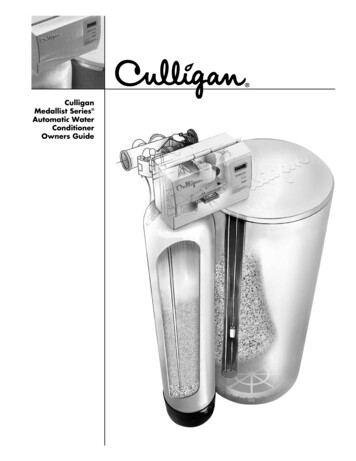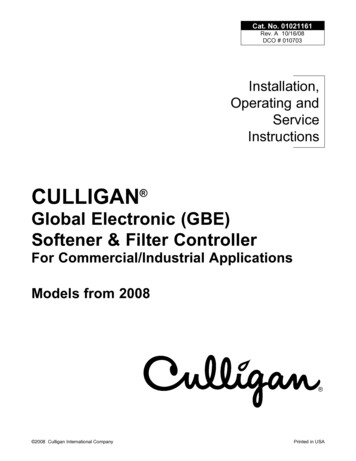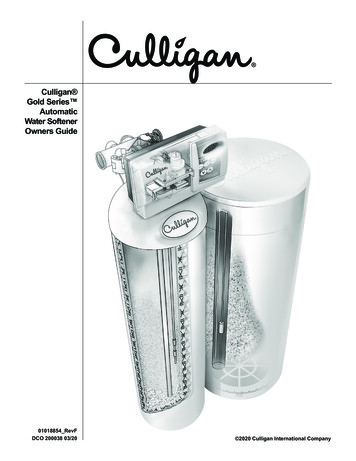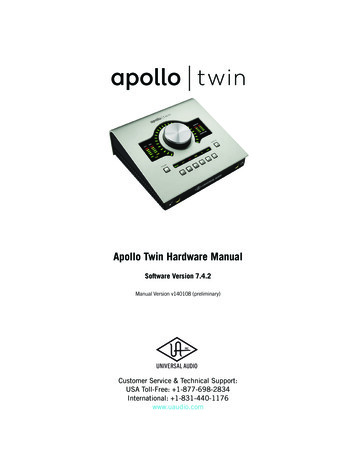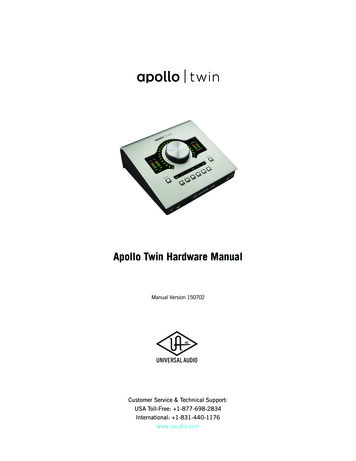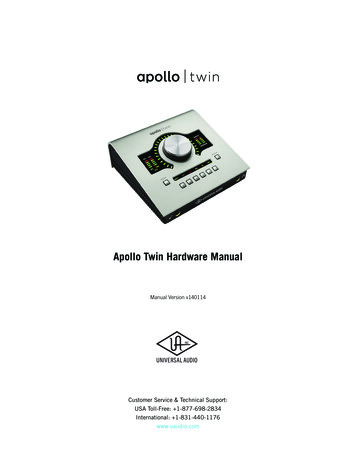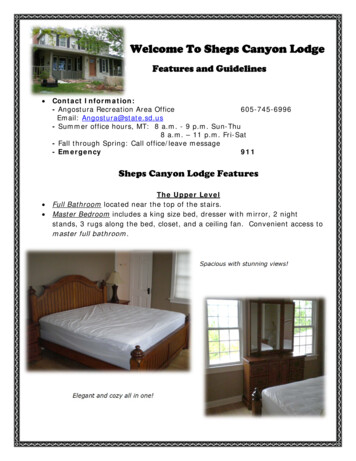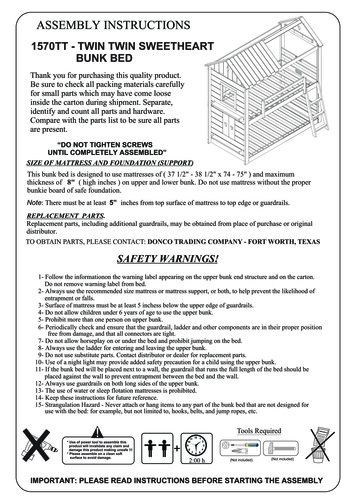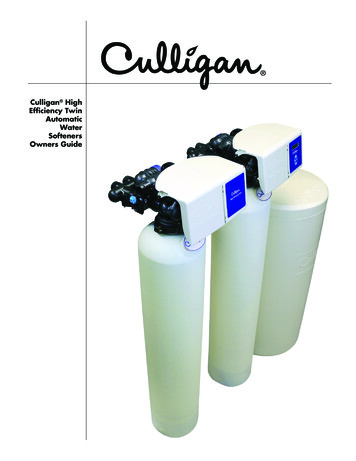
Transcription
Culligan HighEfficiency TwinAutomaticWaterSoftenersOwners Guide
AttentionCulliganCustomerThe installation, service and maintenance of this equipment should be rendered by a qualified and trainedservice technician. Your local independently operated Culligan dealer employs trained service and maintenance personnel who are experienced in the installation, function and repair of Culligan equipment. Thispublication is written specifically for these individuals and is intended for their use.We encourage Culligan users to learn about Culligan products, but we believe that product knowledge isbest obtained by consulting with your Culligan dealer. Untrained individuals who use this manual assumethe risk of any resulting property damage or personal injury.WARNING!NOTEElectrical shock hazard! Prior to servicing equipment, disconnectpower supply to prevent electrical shock.This system is not intended for use where water is microbiologically unsafe or withwater of unknown quality.WARNING!If incorrectly installed, operated or maintained, this product can causesevere injury. Those who install, operate, or maintain this productshould be trained in its proper use, warned of its dangers, andshould read the entire manual before attempting to install, operate,or maintain this product.WARNING!This device complies with part 15 of the FCC rules subject to thetwo following conditions: 1) This device may not cause harmfulinterference, and 2) This device must accept all interference receivedincluding interference that may cause undesired operation.This equipment complies with Part 15 of the FCC rules. Any changes or modifications not expressly approvedby the manufacturer could void the user’s authority to operate the equipment. Changes or modifications notexpressly approved by the party responsible for compliance could void the user’s authority to operate theequipment.CAUTION!To reduce the risk of fire, use only No. 26 AWG or largertelecommunicaitons line cord.CAUTION!This product is not to be used by children or persons with reducedphysical, sensory or mental capabilities, or lack of experience orknowledge, unless they have been given supervision or instruction.CAUTION!Children should be instructed not to play with this appliance.CAUTION!If the power cord from the transformer to the unit looks or becomesdamaged, the cord and transformer should be replaced by a CulliganService Agent or similarly qualified person in order to avoid a hazard.Products manufactured and marketed by Culligan International Company (Culligan) and its affiliates areprotected by patents issued or pending in the United States and other countries. Culligan reserves the right tochange the specifications referred to in this literature at any time, without prior notice. Culligan, AquaSensor,Tripl-Hull, and SoftMinder are trademarks of Culligan International Company or its affiliates.ii01023052Culligan International Company9399 West Higgins Road, Suite 1100Rosemont, Illinois 600181-847-430-2800www.culligan.com
Thank You. 1ContentsSpecifications. 2Introduction. 4How Your Water Conditioner Works. 5The Culligan Process. 6Modes of Operation. 7Navigating the Menus and Keypad . 9Set Date and Time. 10Information. 12Regeneration. 14Salt Supply, Usage and Service . 16Things to Check Before You Call for Service. 17Error Codes. 18When and How to Bypass Your Water Softener. 19Performance Data Sheet. 20Parts List. 33Culligan Limited Warranty. 41With Culligan You Get More Than A Quality Product. 42Index. 4301023052iii
About thisManualThis manual: familiarizes the operator with the equipment explains installation and setup procedures provides basic programming information explains the various modes of operation gives specifications and troubleshooting informationRead this Manual FirstBefore you operate the Culligan High Efficiency Twin Automatic Water Softener, read this manual tobecome familiar with the device and its capabilities.Safe PracticesThroughout this manual there are paragraphs set off by special headings.Notice (or Note) is used to emphasize installation, operation or maintenance information which is important, but does not present any hazard. For example,NOTICEThe nipple must extend no more than 1 inch above the cover plate.Caution is used when failure to follow directions could result in damage to equipment or property.CAUTION! Disassembly while under water pressure can result in flooding.Warning is used to indicate a hazard which could cause injury or death if ignored.WARNING! Electrical shock hazard! Unplug the unit before removing thetimer mechanism or cover plates!The CAUTION and WARNING paragraphs are not meant to cover all possible conditions and situations that mayoccur. Understand that common sense, caution, and careful attention are conditions which cannot be builtinto the equipment. These MUST be supplied by the personnel installing, operating, or maintaining the system.Be sure to check and follow the applicable plumbing codes and ordinances when installing this equipment. Local codes may prohibit the discharge of sanitizing or descaling solutions to drain.Use protective clothing and proper face or eye protection equipment when handling chemicals or tools.iv01023052NOTEThe Culligan High Efficiency Twin Softener is not intended for use with waterthat is microbiologically unsafe or of unknown quality without adequatedisinfection either before or after the system.NOTECheck with your public works department for applicable local plumbingand sanitation codes. Follow local codes if they differ from the standardsused in this manual. To ensure proper and efficient operation of the CulliganHigh Efficiency Twin Softener to your full satisfaction, carefully follow theinstructions in this manual.
Welcome To Your New World of Better Living with Culligan Water.Thank YouThe Culligan HE Twin Water Softeners with Soft-Minder Meter and Aqua-Sensor sensing device are tested and certfied by the WQA and IAPMO R&T against NSF/ANSI Standard 372, CSA B483.1, and NSF/ANSI Standard 44 for the effectivereduction of hardness (calcium and magnesium), barium and radium 226/228, asverified and substantiated by test data.The Culligan HE Twin Water Softeners with Soft-Minder Meter and Aqua-Sensor sensing device are registered for sale with the State of California and the State of Iowa.For installations in Massachusetts, Massachusetts Plumbing Code 248CMR shall be adhered to. Consult your licensed plumber for installationof this system. This system and its installation must comply with stateand local regulations. The use of saddle valves is not permitted.The Culligan HE 1” Twin water softener requires the use of a Culligan connector, P/N 01023290 (plastic)or P/N 01021077 (copper).The Culligan HE 1” Twin NC model has not been tested or certified by WQA or IAPMO R&T and doesnot include the Culligan connector.The Culligan HE Twin water softener outdoor controller enclosure complies with the UL 50/50E and UL746C standards for a NEMA 3R Enclosure Rating.If this is your first experience having soft, conditioned water in your home, you’ll be amazed at the marvelous difference it makes. We promise that you’ll never want to be without it again.Congratulations, too, on selecting one of the “first family” of water conditioners in the prestigious CulliganHigh Efficiency Water Softeners. With Culligan’s many years of knowledge and experience in water treatment, you can be confident that the model you selected has been designed and engineered to provideyears of service with a minimum of care and attention.Some localities have corrosive water. A water softener cannot correct this problem and so its printedwarranty disclaims liability for corrosion of plumbing lines, fixtures or appliances. If you suspect corrosion,your Culligan Dealer has equipment to control the problem.NOTICESodium Information: Water softeners using sodium chloride for regeneration add sodium to the water. Persons who are on sodium restricted dietsshould consider the added sodium as part of their overall sodium intake.Serial NumbersThe control valve serial number is located on the back of the timer case.The media tank serial number is located on the top surface of the tank.NOTEDO NOT remove or destroy the serial number. It must be referenced onrequest for warranty repair or replacement.010230521
SpecificationsCulligan High Efficiency Twin Water Conditioners withAqua-Sensor Device or Soft-Minder Meter—Downflow RegenerationModel9" ModelControl Valve10" Model12" Model14" Model1” Reinforced Thermoplastic w/ HE Circuit BoardsOverall Conditioner Ht56 in62 inMedia Tank Design60 in73 inQuadra-Hull Media Tank Dimensions(Dia x Ht)Salt Storage TankDimensions (Dia x Ht)Exchange Media, Typeand QuantityUnderbedding, Type andQuantityExchange Capacity @Salt Dosage Per Recharge(per tank)9 x 48 in10 x 54 in12 x 52 in14 x 65 in18 x 43 in18 x 43 in18 x 43 in24 x 42 inCullex Media, 1.0 ft3Cullex Media, 1.5 ft3Cullex Media, 2.0 ft3Cullex Media, 3.0 ft3Cullsan Underbedding, 12 lbCullsanUnderbedding, 15 lbCullsanUnderbedding, 20 lbCullsanUnderbedding, 25 lb17,854 gr @ 4.0 lb26,781 gr @ 6.0 lb31,352 gr @ 7.0 lb51,726 gr @ 12 lb27,108 gr @ 8.0 lb40,662 gr @ 12.0 lb48,458 gr @ 16.0 lb75,582 gr @ 24 lb31,736 gr @ 12.0 lb47,604 gr @ 18.0 lb59,267 gr @ 24.0 lb88,549 gr @ 36 lb4,463 gr/lb @ 4 lbsalt dosage4,463 gr/lb @ 6 lbsalt dosage4,479 gr/lb @ 7 lbsalt dosage4,310 gr/lb @ 12 lbsalt dosageFreeboard to Media214.5 in14.5 in16 in25 inFreeboard toUnderbedding344.5 in47.5 in46 in59 inSalt Storage Capacity375 lb375 lb375 lb600 lb9.0 gpm @ 11 psi9.4 gpm @ 12 psi10.0 gpm @ 10 psi10.6 gpm @ 11 psi10.8 gpm @ 15 psi11.0 gpm @ 15 psi12.6 gpm @ 15 psi12.8 gpm @ 15 psi75 gpg99 gpg99 gpg99 gpgEfficiency rated dosage(per tank)1Rated Service Flow @ Pressure DropAuxiliary Flow Rate4Total Hardness, MaximumTotal Iron, Maximum5 ppmHardness to Iron Ratio,Minimum8 gpg to 1 ppmOperating Pressure20-125 psi (138–862 kPa)Operating Pressure(Canada)20-90 psi (138–621 kPa)Operating Temperature33-120 F (0–49 C)Electrical Requirements24V/60 HzElectrical Power Consumption, Min/MaxDrain Flow, Maximum58.4 watts/21.6 watts2.5 gpm2.5 gpm3.0 gpm5.3 gpmRecharge Time, AverageRecharge Water78 minutes67 minutes62 minutes76 minutesConsumption, Average647 gallons45 gallons67 gallons155 gallons61The efficiency rated dosage is only valid at the stated salt dosage and is efficiency rated according to NSF/ANSI Standard 44.2Measured from top of media to top surface of tank threads (backwashed and drained).3Measured from top of underbedding to top surface of tank threads.Auxiliary flow rates do not represent the maximum service flow rate used for determining the softener’s rated capacity and efficiency and that continuousoperation at these flow rates greater than the maximum service flow rate may affect capacity and efficiency performances.42010230525Backwash at 120 psi.610 minute backwash, 4 lb. 9” model, 6 lb. 10” model, 7 lb. 12” model, or 12 lb. 14” model salt dosage.
Culligan High Efficiency Twin Softener—Upflow RegenerationModel9" ModelControl Valve10" Model1” Reinforced Thermoplastic with HE Circuit BoardOverall Conditioner Height56 in62 inMedia Tank DesignQuadra-Hull Media Tank Dimensions (Dia x Ht)9 x 48 in10 x 54 inSalt Storage Tank Dimensions (Dia x Ht)18 x 43 inExchange Media, Type and QuantityUnderbedding, Type and QuantityExchange Capacity @ Salt Dosage Per Recharge (per tank)Efficiency Rated Dosage (per tank)1Proportional Brining Efficiency Rating (per tank)2Freeboard to Media3Freeboard to Underbedding4Cullex Media, 1.0 ft3Cullex Media, 1.5 ft3Cullsan Underbedding, 12 lbCullsan Underbedding, 15 lb9,792 gr @ 2.0 lb30,081 gr @ 6.0 lb17,366 gr @ 4.0 lb47,726 gr @ 12.0 lb27,306 gr @ 8.0 lb54,975 gr @ 18.0 lb4,896 gr/lb @ 2 lb salt dosage5,014 gr/lb @ 6 lb salt dosage5,760 gr/lb @ 2 lb salt dosage5,898 gr/lb @ 6 lb salt dosage14.5 in14.5 in44.5 in47.5 inSalt Storage CapacityRated Service Flow @ Pressure DropAuxiliary Flow Rate5375 lb9.0 gpm @ 11 psi9.4 gpm @ 12 psi10.8 gpm @ 15 psi11.0 gpm @ 15 psiTotal Hardness, Maximum30 gpgTotal Iron, Maximum2 ppmHardness to Iron Ratio, Minimum8 gpg to 1 ppmOperating Pressure20-125 psi (138–862 kPa)Operating Pressure (Canada)20-90 psi (138–621 kPa)Operating Temperature33-120 F (0–49 C)Electrical Requirements24V/60 HzElectrical Power Consumption, Min/MaxDrain Flow, Maximum62.2 gpm2.3 gpmRecharge Time, Average7 Recharge Water68 minutes57 minutesConsumption, Average7 (Evaluated by WQA)33 gallons35 gallons25.5 gallons27.5 gallonsConsumption, Average8 (Not evaluated by WQA)18.4 watts/21.6 wattsThe efficiency rated dosage is only valid at the stated salt dosage and 5-minute backwash. It is efficiency rated according to NSF/ANSI 44.The Proportional Brining Efficiency Rating assumes a 20 percent reserve capacity at the time of regeneration that is typical of what the manufacturer expectsunder real-world operation. Proportional brining is not measured by NSF/ANSI 44, and so this claim is not, and can not, be rated to NSF/ANSI 44.23Measured from top of media to top surface of tank threads. (backwashed and drained).4Measured from top of underbedding to top surface of tank threads.Auxiliary flow rates do not represent the maximum service flow rate used for determining the softener’s rated capacity and efficiency and that continuousoperation at these flow rates greater than the maximum service flow rate may affect capacity and efficiency performances.56Backwash at 120 psi (830 kPa).75-minute backwash, 2 lb. 9” model, 6 lb. 10” model salt dosage. These values have been tested and certified by WQA.82-minute backwash, 2 lb. 9” model, 6 lb. 10” model salt dosage. These values are based on the manufacturer recommended backwash time.010230523
IntroductionIt’s All So Easy, So Economical, So Efficient, So Enjoyable!Kind To Skin And ComplexionSoft water will help prevent red, itchy or dry skin because there are no hardness impurities to cause soreness, no soap curd to coat the skin. Shaving is easier, smoother—either with a blade or electric shaver.Bathing And ShoweringYou’ll use far less soap with conditioned water. Use your soap very sparingly—not as you did before softwater. Just a quick rinse removes all lather, leaving your skin pleasantly smooth and silky because now it’sfree of sticky soap curd and film.Saves Washing Costs. Helps Control Environmental PollutionSoft water washes whiter and cleaner with less soap or detergent. Because the hardness impurities are reduced, your soap can concentrate solely on washing. People usually find that they can reduce the amountof soap they use substantially. If you normally use a cup per wash load with hard water, try using 1/3 cupdepending on the size of your wash load and the degree of soil. Different amounts are required, but youcan use less with softened water. An added bonus is the fact that your washable fabrics will last longer.Super Hair ConditioningSoft water is great for scalp and hair care. No insoluble deposits are formed. Hair is shinier, softer, moremanageable. Reduce the amount of shampoo you have normally used.Dishes Are A DelightWashed by hand or in a dishwasher, glassware, dishes and silver wash cleaner, easier. Follow yourdishwasher manufacturer’s instructions. Soft water promotes sanitation because no greasy hard water filmcan form to collect or harbor bacteria.Easier Housekeeping, Gleaming FixturesYou’ll be amazed at the marvelous difference. Just a swish of the cloth, and the bathtub or shower andfixtures are clean and sparkling. Imagine, no scouring! No hard water scum to cause rings, streaks, spotsand stains. To keep their gleaming luster, simply wipe fixtures with a towel after use. Formica, tile, walls,floors, woodwork surfaces clean easier, stay clean longer. You’ll save on cleaning aids and save on time.Saves Water-Heating Energy, Helps Water-Using AppliancesSoft water reduces the formation of rock-like hard water scale that encrusts water heaters, hot water pipes,shower heads, and water-using appliances. This scale can cause premature maintenance and failure.Elimination of hard water also provides substantial energy savings because scale acts as an insulator,wasting electricity or gas used to heat water.Water For Lawns And Household PlantsIf possible, lawn sprinkling faucets should be supplied with hard water primarily because it is uneconomical to soften so much water.Household plants are much more sensitive than lawns with respect to the kind of water which is best. First,because they receive no rainfall and, second, there is little or no drainage of the soil. Preferably theyshould be watered with rainwater or water which is low in mineral content such as distilled or demineralized water. Softened water is not recommended for house plants because a build-up of sodium in the soilmay interfere with efficient absorption of water by the plant root system. Additional information may beobtained from your independently operated Culligan dealer.401023052
Why Water Gets Hard And How It Is SoftenedAll of the fresh water in the world originally falls as rain, snow, or sleet. Surface water is drawn upwardby the sun, forming clouds. Then, nearly pure and soft as it starts to fall, it begins to collect impurities as itpasses through smog and dust-laden atmosphere. And as it seeps through soil and rocks it gathers hardness, rust, acid, unpleasant tastes and odors.How YourWaterConditionerWorksWater hardness is caused primarily by limestone dissolved from the earth by rainwater. Because of this,in earlier times people who wanted soft water collected rainwater from roofs in rain barrels and cisternsbefore it picked up hardness from the earth.Some localities have corrosive water. A softener cannot correct this problem and so its printed warrantydisclaims liability for corrosion of plumbing lines, fixtures or appliances. If you suspect corrosion, yourCulligan Man has equipment to control the problem.Iron is a common water problem. The chemical/physical nature of iron found in natural water supplies isexhibited in four general types:1.Dissolved Iron—Also called ferrous or “clear water” iron. This type of iron can be removedfrom the water by the same ion exchange principle that removes the hardness elements, calciumand magnesium. Dissolved iron is soluble in water and is detected by taking a sample of thewater to be treated in a clear glass. The water in the glass is initially clear, but on standingexposed to the air, it may gradually turn cloudy or colored as it oxidizes.2.Particulate Iron—Also called ferric or colloidal iron. This type of iron is an undissolved particle of iron. A softener will remove larger particles, but they may not be washed out in regeneration effectively and will eventually foul the ion exchange resin. A filtering treatment will berequired to remove this type of iron.3.Organic Bound Iron—This type of iron is strongly attached to an organic compound in thewater. The ion exchange process alone cannot break this attachment and the softener will notremove this type of iron.4.Bacterial Iron—This type of iron is protected inside a bacteria cell. Like the organic boundiron, it is not removed by a water softener.When using a softener to remove both hardness and dissolved iron it is important that it regenerates morefrequently than ordinarily would be calculated for hardness removal alone. Although many factors andformulas have been used to determine this frequency, it is recommended that the softener be regeneratedwhen it has reached 50–75 percent of the calculated hardness alone capacity. This will minimize thepotential for bed fouling. (Iron removal claims have not been verified by the Water Quality Association.)If you are operating a water softener on clear water iron, regular resin bed cleaning is needed to keep thebed from coating with iron. Even when operating a softener on water with less than the maximum of dissolved iron, regular cleanings should be performed. Clean every six months or more often if iron appearsin your conditioned water supply. Use resin bed cleaning compounds carefully following the directions onthe container.CAUTION!Do not use where the water is microbiologically unsafe or with waterof unknown quality without adequate disinfection before or after theunit.010230525
The CulliganProcessYour Culligan water conditioner consists of three basic components, (A) the Control Valve, (B) the MineralTank, and (C) the Brine System.A. Control ValveAThe exclusive Culligan control valve automaticallyperforms a variety of tasks that are necessary for theproper operation of your water conditioner. These tasks,commonly referred to as cycles or operating positions,are Service, Regeneration, and Brine Refill.1.Service: While the control valve is in theservice cycle, hard water is directed downthrough the column of Cullex resin wherehardness minerals are removed from thewater. The softened water is then directed intoyour household plumbing lines. The ability ofthe Cullex resin to remove hardness mineralsneeds to be periodically replenished; this isreferred to as CB2.Regeneration: While the control valve is inthe regeneration cycle, water is first directedup through the column of Cullex resin to flush accumulated sediment out of the resin and downthe drain. Then, the regenerant brine solution is slowly drawn from the bottom of the salt storagetank of the Brine System and is directed down through the column of Cullex resin, restoring theability of the resin to remove hardness minerals from your water supply. Once completed, theregeneration cycle is followed by 3.Brine Refill: While the control valve is in the brine refill cycle, a predetermined amount ofwater is directed to the salt storage tank of the Brine System so that additional salt can be dissolved to provide the brine solution that will be needed for the next regeneration cycle.B. The Mineral TankThe Mineral Tank contains the Cullex resin column, Cullsan underbedding, and an outlet manifold (theCulligan Municipal also includes carbon media for chlorine taste & odor reduction). The number of gallonsof hard water that can be softened by the Cullex resin column before it needs regeneration is called the“capacity” of the resin column, and depends upon the amount of hardness minerals in each gallon ofwater (expressed as grains per gallon) and upon the amount of regenerant brine solution (expressed aspounds of salt) passed through the resin column during regeneration.Your Culligan service person, taking into account the hardness of your water and the amount of softenedwater your household may reasonably expect to use each day, has carefully established how often thesoftener will regenerate and how much salt will be used for each regeneration. This will ensure that all ofyour soft water needs will be fulfilled without using an excessive amount of salt.C. The Brine SystemThe Brine System consists of a salt storage container and hydraulic Dubl-Safe valve. The salt storage container holds the salt that is used to make the regenerant brine solution. The hydraulic Dubl-Safe valve limitsthe amount of water that is returned to the salt storage tank during the brine refill cycle.Because a predetermined amount of salt is dissolved with each brine refill cycle, the salt must be periodically replenished in order to maintain efficient operation. Your Culligan service person will be able to tellyou about how often salt must be added to the salt storage container.601023052
Water Meter ModeIn water meter mode, the controller keeps track of the quantity of water that has flowed through the resinbed. Based on the influent water hardness and the hardness capacity of the resin bed, a service life expectancy in the quantity of softened water is calculated and programmed into the control. When the set pointis reached, regeneration is triggered. If the delayed regeneration is selected, the regeneration will start attime of regeneration. In immediate mode the regeneration starts as soon as the regeneration signal is provided. If time clock backup is set and the capacity has not been exhausted but the days since last regen isgreater than time clock backup, setting the softener will immediately regenerate.Modes ofOperationAqua-Sensor ModeThe Aqua-Sensor is a conductivity probe that senses when the hardness front passes through the resinbed. It functions independently of the influent water hardness so therefore, is useful in conditions when theinfluent water hardness varies throughout the year. It provides for the most efficient mode of operation. Inaddition to sensing when a resin bed is exhausted, it can also be used to determine when the brine solution is rinsed from the resin bed during the Brine Draw/Slow Rinse cycle triggering the control to move tofast rinse. This patented feature provides water savings by optimizing the amount of rinse water requiredto completely rinse out the resin bed.Smart Brine Tank ProbeThe smart brine tank probe monitors conditions inside the brine tank. It predicts when salt needs to beadded to the brine tank, detects the presence of salt-bridging, eductor line plugging and brine tank overfilling.Wireless Remote ControlThe wireless remote control displays the current status of the water softener or filters and allows for remotecontrol. It can be located up to 200 feet away from the softener (depending upon building constructionmaterials). The wireless remote displays information about softener performance, problems, days of saltremaining and allows remote control for regeneration.The wireless remote control is designed to communicate at 915 MHz and to work without interference withother 915 MHz devices such as cordless telephones and baby monitors.ModemThe modem allows for the system to be remotely monitored detecting problems before they occur, to schedule salt delivery when it is needed and to keep the system software up to date with the latest advances.Manual RegenerationManual regeneration can be initiated via the softener control valve or wireless remote display. Manual regeneration can be initiated to begin regeneration immediately or that night. To immediately initiate regeneration,press and holdfor at least ten (10) seconds. To cancel a delayed regeneration, press and holdfor at leastfive (5) seconds.Predict ModeThe Predict Mode is used with the flow meter to determine the optimum regeneration point. Before the regeneration starts, the control will compare the remaining capacity value with the average daily water use.If the average daily water usage is less than the reserve capacity, the controller will wait 24 more hoursbefore regeneration. If the reserve capacity is less than the average daily water usage, the control willinitiate regeneration. This works in delay mode only. At any time, if the total capacity value is reached,the control will initiate an immediate regeneration.Pre-Rinse ModeThe Pre-rinse mode is used to pre-rinse the softener resin bed or filter media. The pre-rinse in flow metermode will occur after the control has sensed that no water has flowed through the control for a period of Xhours (can be set through the programming menu). When the control is in this mode, once the X amount010230527
of hours have elapsed the control will cycle to the fast rinse position for the pre-set length of minutes andthen return to the home or service position.Down Flow RegenerationWater and regenerate flow downward through the media tank.Up Flow RegenerationWater flow is downward and regenerate flow is upward through the media tank. The significance of thisis that regeneration will be most effective in those parts of the resin bed which are treated with the freshestregenerate solution. There will tend to be less hardness leakage with up-flow regeneration.Proportional BriningThe control monitors your softened water u
Some localities have corrosive water. A water softener cannot correct this problem and so its printed warranty disclaims liability for corrosion of plumbing lines, fixtures or appliances. If you suspect corrosion, your Culligan Dealer has equipment to control the problem. NOTICE Sodium Information: Water softeners using sodium chloride for regenera-tion add sodium to the water.
